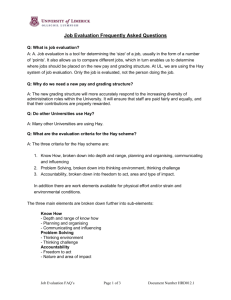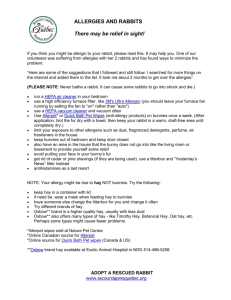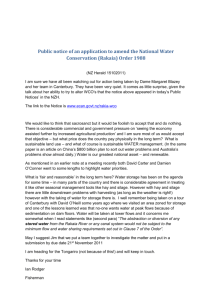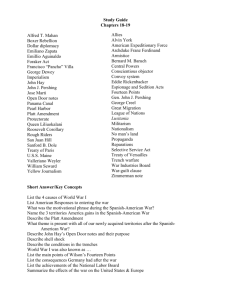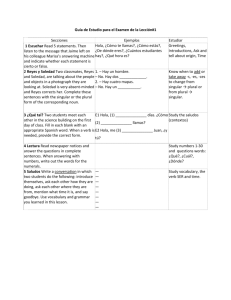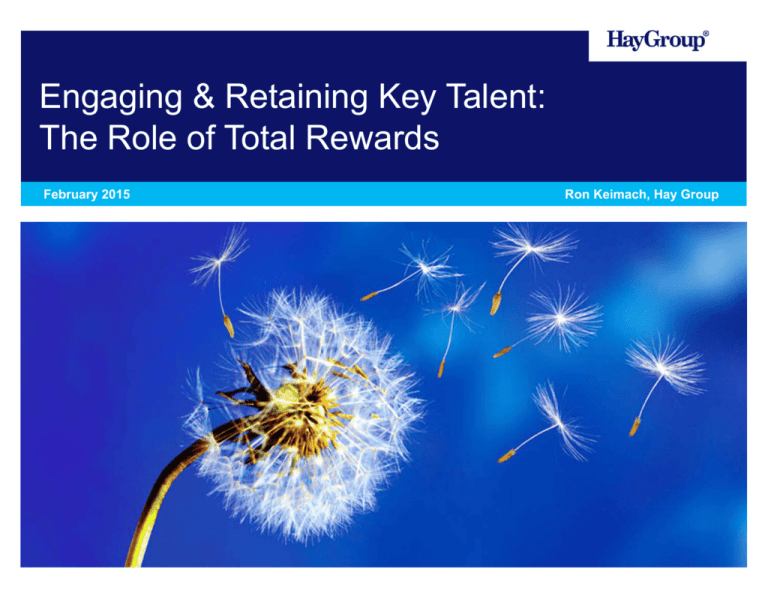
Engaging & Retaining Key Talent:
The Role of Total Rewards
February 2015
Ron Keimach, Hay Group
Today’s Discussion
Talent trends
Staying Competitive
Turnover, Engagement, and Enablement
Next Practices
Implementation
© 2015 Hay Group. All rights reserved
2
Talent Management Challenges
Targeting
top talent
© 2015 Hay Group. All rights reserved
Engagement is
no longer
optional
A new view on
performance
The best
system is not
a substitute for
management
3
Why is this important?
Economy starting to recover
Unemployment down to 7.5%, and still falling
Real wages are increasing
3.9% for college graduates
An increasing number of Americans are quitting their jobs
There is a “demographic hole”
20% of employees intend to quit in the next two years
Number of job changes are increasing
© 2015 Hay Group. All rights reserved
4
Talent shortages coming
U.S. Talent Shortages 2010-2020
Categories
Shortfall
Engineers
50M – 250M
Doctors
55M – 200M
Scientists
100M – 200M
Health Technicians
200M – 400M
Nurses
340M – 1MM
Information Technology
500M – 1MM
Teachers
500M – 1MM
Sources: Bureau of Labor Statistics & Professional Associations
© 2015 Hay Group. All rights reserved
5
Serious skills shortfall by sector
Aerospace & Defense
Life Sciences & Med. Devices
Energy & Resources
Industrial Products
Consumer Products
Other
0%
10% 20% 30% 40% 50% 60% 70%
Source: Manufacturing Industry Survey by Deloitte, Oracle, & Manufacturing Institute
© 2015 Hay Group. All rights reserved
6
Identifying key talent
Key talent defined as top performers, high
potentials, empl.s in critical jobs
79%
Our identification of key talent goes below the
executive level
75%
66%
We have actually identified key talent
57%
We have a clear definition of key talent
Retention efforts focuses primarily on key talent
versus all employee base
55%
0%
10%
20%
30%
40%
50%
60%
70%
80%
90%
% Agree and Strongly Agree
Source: Hay Group research
© 2015 Hay Group. All rights reserved
7
Is retaining key talent a significant challenge?
Turnover of key employes is very costly for our
organization
81%
Employee retention of key talent is a major
concern of senior management right now
68%
I expect turnover of key talent to increase
substantially when the economy improves
60%
Retention of key talent has become more difficult
in recent months
58%
Confident in my organization's ability to retain key
talent as the economy improves
57%
I expect a substantial number of key employees to
search for a better job as the economy improves
54%
0%
20%
40%
60%
80%
100%
% Agree & Strongly Agree
Source: Hay Group research
© 2015 Hay Group. All rights reserved
8
Easy for key talent to leave
Key talent always scarce especially during economic recovery
You can’t hide key talent; Linked-in and social media promote their capabilities and
accomplishments
Top talent can compare their “deal” with everyone else’s on salary.com, vault.com,
O’net.gov, etc.
Your company reputation is always on the line; a disgruntled employee has an
audience of millions
Whole Foods
employee’s rant goes
viral
© 2015 Hay Group. All rights reserved
Workplace experts
weigh in on a
commentary by
departing Goldman
Sachs executive Greg
Smith
Feds: trashing an
employer on
Facebook is
protected speech
9
Most likely reasons why key talent quits
Percent who responded “to some extent,” “to a great extent,” and “to a very great extent.”
© 2015 Hay Group. All rights reserved
10
Key predictors of employee retention
Total Percent Favorable
Employees
planning to stay
for >2 years
Employees
planning to leave
within 2 years
Gap
Confidence in ability to achieve career objectives at
company
64%
31%
33%
Trust and confidence in company senior management
60%
35%
25%
Opportunities for learning and development
71%
45%
25%
Benefits that meet employee needs
68%
45%
23%
Company demonstrates care and concern for
employees
62%
39%
23%
Company is effectively managed and run well
73%
51%
23%
Adequate authority to do job
73%
51%
23%
Employees paid fairly for the work they do
53%
31%
22%
Supervisory coaching for development
67%
45%
22%
Support for employee creativity and innovation
70%
48%
22%
Cross-work unit collaboration and support
63%
41%
22%
Direction and goals are the right ones for the company
73%
51%
22%
© 2015 Hay Group. All rights reserved
Source: Hay Group Employee Opinion Norms (2013)
11
Methods most often used to retain key talent
% Effective or
Very Effective
Identified key employees who are essential to
the business
85%
75%
Discussed future opportunities within the
organization
80%
69%
75%
73%
Created a succession plan to replace individuals
74%
63%
Developed employees who may replace key
employees who leave
73%
64%
Provided tuition reimbursement/other
educational opportunities
73%
53%
Allowed for flexible hours or telecommunting
68%
67%
Provided meaningful pay communications
65%
59%
Pay employees above the labor market
0%
20%
40%
60%
80%
100%
% Use these methods
© 2015 Hay Group. All rights reserved
12
Cost of turnover estimates
Job Type/Category
Turnover cost ranges (% of annual wages)
Entry Level – Hourly, Non Skilled (e.g. Fast Food Worker)
30% ‐ 50%
Service/Production Workers ‐ Hourly (e.g. Courier)
40% ‐ 70%
Skilled Hourly (e.g. Machinist)
75% ‐ 100%
Clerical/Administrative (e.g. Scheduler)
50% ‐ 80%
Professional (e.g. Sales Representative, Nurse, Accountant)
75% ‐ 125%
Technical (e.g. Computer Technician)
100% ‐ 150%
Engineers (e.g. Chemical Engineer)
200% ‐ 300%
Specialists (e.g. Computer Software Designer)
200% ‐ 400%
Supervisors/Team Leaders (e.g. Section Supervisor)
100% ‐ 150%
Middle Managers (e.g. Department Manager) 125% ‐ 200%
Source: ROI Institute
© 2015 Hay Group. All rights reserved
13
Turnover cost components
Exit cost of previous employee
Lost productivity
Temporary worker cost
Recruiting cost
On-boarding costs
Training costs
Supervisor’s/coworkers’ time managing turnover
Loss of expertise/knowledge
Quality problems
Customer dissatisfaction
© 2015 Hay Group. All rights reserved
14
A look at the cost of turnover
© 2015 Hay Group. All rights reserved
15
Reward program management in the C-suite
The current global economic environment has created a new landscape of how executives
are thinking about reward program management
A 2013 Conference Board Survey of CEO Challenges ranks human capital concerns #1
2012 SHRM survey identified “retaining and rewarding the best employees as the number
one challenge” of senior HR executives
Dominant C-suite reward-related themes* are:
Optimizing productivity and cost effectiveness
Improving employee engagement
Development and retention of key talent
Improving performance management processes
Aligning human capital and reward systems to business strategy
Source: Hay Group research of various 2011-2013 studies
© 2015 Hay Group. All rights reserved
16
A positive intersection
Work environments must turn motivation into productivity
Employee effectiveness
Business results
Strategic intent
Engagement
Enablement
© 2015 Hay Group. All rights reserved
17
Engagement and enablement are key to
effectiveness
Clear & promising direction
Confidence in leaders
Quality & customer focus
Respect & recognition
Development opportunities
Pay & benefits
Employee engagement
Commitment
Discretionary effort
EMPLOYEE
EFFECTIVENESS
DRIVERS
Productivity
Financial
performance
Attracting and
retaining talent
Customer loyalty
Performance management
Authority & empowerment
Resources
Training
Collaboration
Work, structure & process
© 2015 Hay Group. All rights reserved
Employee enablement
Innovation
Optimized roles
Supportive
environment
Enhanced
reputation
18
The business case for engaging and
enabling employees
Employee
performance
Increase in
employees above
performance
expectations
Employee
retention
Reduction in
turnover rates
Customer
satisfaction
Customer
satisfaction rates
Financial
success
Revenue growth
High
engagement
only
10%
-40%
71%
x2.5
High
engagement +
high enablement
50%
-54%
89%
x4.5
Based on linkage case studies using
Hay Group’s global normative database
© 2015 Hay Group. All rights reserved
19
Engagement and enablement:
Implications for action
Engagement and enablement
are both important
determinants of employee
performance
Organizations are unlikely to
sustain one without the other
Frustrated employees will
break through barriers,
disengage, or leave the
organization
© 2015 Hay Group. All rights reserved
HIGH
Enablement
LOW
DETACHED
EFFECTIVE
INEFFECTIVE
FRUSTRATED
Engagement
HIGH
20
Engagement: The impact of financial rewards
© 2015 Hay Group. All rights reserved
21
Engagement: The impact of non-financial rewards
© 2015 Hay Group. All rights reserved
22
Reward program questions
How has the economic collapse and recovery transformed
reward strategies and programs?
How effective are current reward strategies, programs and
processes?
How will reward strategies, programs and processes change
over the next 2-3 years?
© 2015 Hay Group. All rights reserved
23
Examine rewards from four perspectives
Characteristics of reward strategies
Effectiveness of reward program design
Implementation of reward programs
Degree of reward program consistency
© 2015 Hay Group. All rights reserved
24
Issues with reward practices today
Strategy and
design
Implementation
© 2015 Hay Group. All rights reserved
Lack of robust reward strategies
Extreme focus on benchmarking for many, with little concern
given to affordability of pay programs
Reward components managed in isolation of each other
Little input from employees on reward strategy and design
Boards and CEOs concerned with risk and compliance
Performance management processes often weak
The value of “total rewards” is not understood by employees
Line managers are not well engaged in reward implementation
Little done in terms of reward ROI assessment
25
Is reward a cost or an investment?
Our organization regularly
measures the ROI on its reward
investment
48%
11%
80%
60%
40%
20%
% current focus
0%
20%
40%
60%
80%
% greater focus in future
Why do we care?
If pay is a cost, the obvious goal is to minimize it
If pay is an investment, the obvious goal is to optimize it
© 2015 Hay Group. All rights reserved
26
If reward is viewed as an investment…
Organizations focus on…
Aligning rewards with its business and human capital strategy
Balancing employee and organization reward interests
Reinforcing the link between rewards and performance
Distilling down and sustaining key reward communications
Leveraging senior leaders, managers and employees in reward implementation
© 2015 Hay Group. All rights reserved
27
Reward strategy trends
FROM
TO
Externally competitive
Motivational
Inconsistent strategy and design
Consistent strategy and design
Short term performance orientation
Longer term performance orientation
Financial performance measures
Balanced performance measures
Cost orientation of reward
ROI orientation of reward
© 2015 Hay Group. All rights reserved
28
Core reward strategy objectives
Increased emphasis on motivational value of reward programs
Is externally competitive
64%
Is internally fair
53%
75%
41%
Is motivational
39%
Rewards at a
reasonable cost
67%
74%
80%
60%
47%
40%
20%
% current focus
0%
20%
40%
60%
80%
% greater focus in future
Source: Hay Group/WaW Global Survey, 2012
© 2015 Hay Group. All rights reserved
29
Balanced performance
Increased focus on drivers of financial performance and engagement
Financial performance
39%
66%
Customer satisfaction
39%
41%
Human capital development
A culture of innovation
42%
21%
Employee engagement
80%
39%
15%
56%
32%
60%
40%
20%
% current focus
0%
20%
40%
60%
80%
% greater focus in the future
Source: Hay Group/WaW Global Survey, 2012
“There are only three measurements that tell you nearly everything you need to know
about your organization’s overall performance: employee engagement, customer
satisfaction, and cash.“
Jack Welch, former CEO of GE
© 2015 Hay Group. All rights reserved
30
Reward design trends
FROM
TO
Base pay program management
Variable pay program management
Paying for jobs/work
Paying for value/contribution
Flexible work arrangements
Career dev’lmt, culture, recognition
Defined benefit plans
Defined contribution plans
Siloed reward element orientation
Ttl remuneration/rewards orientation
© 2015 Hay Group. All rights reserved
31
Non-financial reward program effectiveness
Career/development opportunities primary focus in the future
Education & training programs
50%
Career/development opportunities
39%
Flexible work arrangements
32%
38%
43%
57%
Work-life balance
48%
48%
Meaningful job design
80%
63%
50%
Nonfinancial recognition
Work climate/culture
54%
38%
37%
60%
40%
31%
20%
% current focus
0%
20%
40%
60%
80%
% greater focus in future
Source: Hay Group/WaW Global Survey, 2012
© 2015 Hay Group. All rights reserved
32
Reward implementation trends
FROM
TO
Reward program design
Reward program implementation
Consistent treatment in pay
Performance-based differentiation
HR-led implementation
Line manager-led implementation
Ad-hoc reward communications
Sustained senior leader messaging
© 2015 Hay Group. All rights reserved
33
Differentiation in pay
Difference in pay increases for
TOP performers vs. average
But Most Admired(s) find a way
(companies w/ a 2x differential)
(all companies)
80%
80%
68%
40%
40%
53%
32%
0%
We pay 1.5
times or less
We pay 2
times or more
32%
0%
Americas most
admired
Other
respondents
Source: Hay Group, Dow Scott, Ph.D., Loyola University Chicago, WorldatWork
“The A’s (the top 20%) should be getting raises that are two-to-three times the size
given to the B’s. B’s should get solid increases recognizing their contributions every
year. C’s (the bottom 10%) must get nothing.”
Jack Welch, former Chairman & CEO, GE
© 2015 Hay Group. All rights reserved
34
Role of line managers
Future focus for managers to effectively communicate total rewards
Managers effectively implement and
communicate total rewards to
employees
11%
Managers effectively manage overall
pay-for-performance relationship for
employees
80%
60%
40%
61%
15%
20%
% current focus
57%
0%
20%
40%
60%
80%
% greater focus in future
Source: Hay Group/WaW Global Survey, 2012
© 2015 Hay Group. All rights reserved
35
Implementation –
The top seven list
1.
Make a business case for engaging and retaining employees
2.
Get to a total rewards mindset
3.
Clarify key talent management program
4.
Develop a differentiated reward strategy for key talent
5.
Develop a counter-offer strategy
6.
Leverage critical jobs
7.
Monitor program effectiveness
© 2015 Hay Group. All rights reserved
36
1. Make a business case for engaging and
retaining employees
Educate management about the correlation between high engagement and hard
business metrics
Educate management about cost of turnover to the company
Continually measure engagement and retention at your company
© 2015 Hay Group. All rights reserved
37
2. Get to a total rewards mindset
Educate managers and employees about the total value proposition of working at
your company
Develop tools for managers so they can effectively reward employees beyond the
confines of compensation and benefits
Continually communicate the non-financial benefits of working at your company
© 2015 Hay Group. All rights reserved
38
3. Clarify key talent management program
Develop clarity around what defines “key talent” and around the definition of “high
potential,” specifically “potential for what?”
Identify governance structure and roles of corporate, BU and function leadership in
key talent management processes
Ensure transparency in talent reviews and ensure a substantive role of functions to:
Minimize sense of talent ownership by business
Improve collaboration and calibration processes
Articulate top talent communications strategy
Do we communicate status? Why? Why not?
Identify the benefit and risks of communication
Identify messages, messengers and mediums of communications
© 2015 Hay Group. All rights reserved
39
4. Develop a differentiated reward
strategy for key talent
Clarify reward strategy for key talent
Determine degree of variation, if any, vs. other employee groups
Include principles, design and communications
Common programs include more aggressive base salary positioning, off-cycle pay
increase and restricted stock grants
Monitor performance and reward differentials for top talent vs. others to ensure
appropriate differentiation
Differentials across all cash reward elements
Differentials in treatment across non-financial reward programs
On a current year and multi-year (i.e., career income) basis
© 2015 Hay Group. All rights reserved
40
5. Develop a counter-offer strategy
Develop a counter-offer strategy that consists of clarifying:
The types of people/jobs that are eligible for counter-offers
The role HR, management and senior management play
The information to collect to formulate a counter-offer
How to structure and communicate the counter-offer
How to respond to other employees who may learn about the counter-offer
How to limit the need for making counter-offers in the future
Recognize that work climate issues often trigger a search for a new job
Nonetheless, many counter-offer and retention strategies focus on pay increases,
retention bonuses, and stock options
Ensure you have a good understanding of the real issues and take action on them
© 2015 Hay Group. All rights reserved
41
6. Leverage critical jobs
Leverage the notion of a “critical job” or “accelerator experiences”
Clarify purposes, application and process of a critical job
Align top talent management with management of critical job post; clarifying
eligibility requirement on who can assume a critical job
Develop principles around job evaluation “lean forward” or “grandfather” situations
(e.g., eligibility, decision rights, time windows, communications)
© 2015 Hay Group. All rights reserved
42
7. Monitor program effectiveness
Measure program effectiveness
Develop criteria for program effectiveness assessment
Involve top talent in developing the strategy and evaluation of top talent
Common measures include:
Velocity of key talent through the pipeline
Growing the amount of key talent in the organization
Retention rate of top talent
Active involvement of CEO and C-suite is a key program enabler
© 2015 Hay Group. All rights reserved
43
About Hay Group
Hay Group has consulted
with 10,000 clients
worldwide in a wide variety
of areas, including:
Organizational
effectiveness
Managerial and
executive assessment
Compensation
and benefits
Performance
management
Executive remuneration
and corporate governance
Employee and customer
attitude research
© 2015 Hay Group. All rights reserved
89
2800+
10,000
Offices in 47
countries (10 in NA)
Employees
worldwide
International clients
44
Contact Information
Ron Keimach
Principal
ron.keimach@haygroup.com
415.644.3707
(c) 510.285.7436
www.haygroup.com
© 2015 Hay Group. All rights reserved
45


